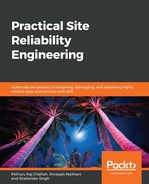This chapter hopes to reassure you that the future is bright that is things are changing in the cloud era, and we will soon be able to use the right programming language to support our thinking. We will be able to write code using FaaS, microservices, and endpoints, to which IoT devices will send data. Almost everything will go through gateways and hit your services through APIs. In the last three decades, we have seen the development of many programming languages, which have been worked on by numerous programmers. Are all these programming languages meant for the future? We would say no; very few languages provide appropriate support for the world of integration through APIs. Node.js is perhaps the only one that is trying to fulfil the principles of REST programming.
In this chapter, we are going to cover the language of the future. It has been referred to as the first cloud-native programming language and lauded as flexible, powerful, and beautiful. Yes, we are going to cover Ballerina, is a totally new programming language, that is compiled, static, rich in data types, and strongly typed. It has support for XML, uses JSON, and has a textual and graphical syntax. Yes, a graphical syntax! Be prepared to be amazed by this language. It will provide you with a complete overview of your logic when coding in your IDE.
We are also going to cover a second programming language, which is Rust. We are going to cover the following topics:
- Ballerina programming
- Rust programming
- Concepts related to reliability
